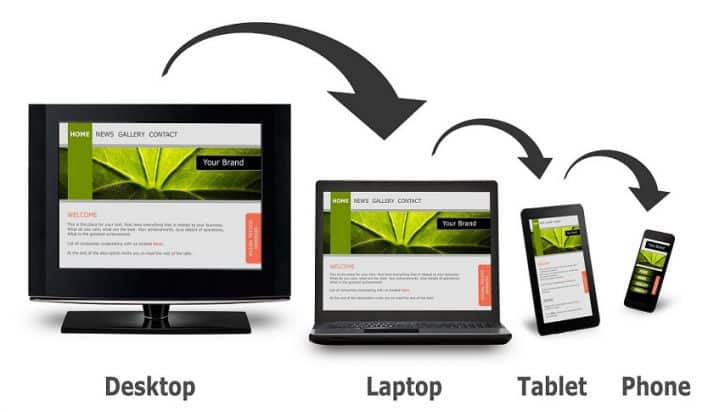Top Features of Advanced Websites
An advanced website in the digital age is more than simply a place to store content; it’s an interactive platform that engages people, makes navigation easier, and increases conversions. To stand out and stay competitive, advanced websites combine cutting-edge technologies, user-focused functionality, and compelling design. This essay will examine the fundamental components—from responsiveness to cutting-edge features—that constitute a really sophisticated website.
1. Responsive and Mobile-Optimized Design
Having a responsive design is essential as mobile traffic grows. Sophisticated websites improve user experience on all platforms by fluidly adjusting to various screen sizes.
Why Mobile Optimization Matters
For smartphones and tablets, a mobile-optimized website modifies layouts, pictures, and navigation. Websites that aren’t optimized run the danger of losing a lot of users, as mobile devices account for more than half of all web traffic.
Core Aspects of Responsive Design
Flexible grids, media queries, and optimized images are used by responsive websites to dynamically modify content. This guarantees quick loading times and a user-friendly design across all platforms.
2. Fast Loading Speeds
One important aspect of the user experience is speed. A sluggish website might drive visitors away before they can interact, which hurts SEO and conversion rates.
Optimizing for Speed
Sophisticated websites minimize code, use browser caching, and compress graphics to speed up page times. These methods, in conjunction with Content Delivery Networks (CDNs), provide faster content loading for users across the globe. For websites in docklands, we can help you.
The Role of Core Web Vitals
The most important criteria for assessing page speed are Google’s Core Web Vitals: Cumulative Layout Shift, First Input Delay, and Largest Contentful Paint. Optimizing these KPIs is a top priority for sophisticated websites in order to enhance user experience and search engine rankings.
3. User-Centered Interface and Navigation
Users can easily find what they need on a sophisticated website thanks to its clear pathways. This experience is improved in large part by user-centered design and simple navigation.
Creating a User-Centric Interface
It is important for user interfaces to be clear, simple, and accessible. Buttons, menus, and calls-to-action (CTAs) are thoughtfully positioned to make browsing simple and pleasurable.
Navigation Best Practices
Clear headlines, links that are easy to find, and a straightforward structure are all necessary for effective navigation. Sticky navigation, breadcrumbs, and mega menus can all assist users navigate without getting lost.
4. Advanced Security Features
Internet security is crucial. Strong security elements are implemented by sophisticated websites to safeguard user information and guarantee privacy, particularly on membership or e-commerce sites.
SSL Encryption
SSL encryption protects sensitive data, such as login credentials or payment information, by securing data sent between the user’s browser and the server. The “HTTPS” in their URL indicates that an SSL certificate is usually present on advanced websites.
Multi-Layered Security Measures
Advanced websites use security features like two-factor authentication (2FA), frequent software updates, and security plugins to fend against risks like hacking or data leaks. PCI DSS (Payment Card Industry Data Security Standard) compliance is essential for e-commerce websites.
5. SEO Optimization
For visibility, SEO is crucial. In order to raise their search engine ranks and increase organic traffic, sophisticated websites combine on-page and off-page SEO strategies.
On-Page SEO Elements
The strategic use of keywords, informative meta tags, and optimized pictures are all necessary for effective on-page SEO. Schema markup, also known as structured data, aids search engines in comprehending material and may increase the prominence of search results.
Technical SEO and Site Structure
By enhancing site architecture, enabling crawlability, and developing an XML sitemap, advanced websites give technical SEO top priority. A strong technical SEO strategy also includes canonical tags, mobile friendliness, and page performance. https://diversewebsitedesign.com.au/website-maker/
6. Interactive and Engaging Content
Although content is crucial, sophisticated websites are more than just static text and pictures. Users are kept interested and inspired to learn more with interactive material.
Types of Interactive Content
Interactive material includes things like surveys, quizzes, infographics, and animations. In order to create an immersive experience, sophisticated websites may also incorporate 360-degree product views, calculators, or video testimonials.
Video Integration for Engagement
Engagement is increased via video material, such as client testimonials and tutorials. Because search engines prefer pages with a variety of media formats, including videos not only increases time on page but also aids SEO efforts.
7. Personalized User Experience
By customizing promotions, recommendations, and content to each user’s tastes, personalization revolutionizes user interactions.
Using Data for Personalization
To personalize the experience, sophisticated websites incorporate information about user demographics, activity, and previous interactions. Personalized greetings, recommendations, or special deals increase user loyalty and satisfaction.

AI-Driven Personalization
Websites may now examine user activity in real time thanks to AI and machine learning. This makes the site feel more relevant to each user by delivering dynamic information and product recommendations.
8. Integration of AI and Chatbots
Chatbots and artificial intelligence improve customer service, expedite the user experience, and offer instant support.
The Role of AI Chatbots
Chatbots help consumers navigate websites, respond to frequently asked questions, and offer round-the-clock assistance. Additionally, bots with AI capabilities can evaluate user queries and gradually offer more tailored answers.
Benefits of AI for Advanced Websites
AI is capable of analyzing data patterns, spotting possible problems, and offering insights to enhance site performance in addition to chatbots. Additionally, AI tools may automate content creation, SEO, and personalization, which will make the website smarter and more effective.
9. Accessibility Features
An advanced website is characterized by its inclusivity. Users with impairments can navigate and engage with the website thanks to accessibility features.
Core Accessibility Elements
Features like keyboard navigation, screen reader compatibility, font size adjustments, and alt text for images are all part of accessible websites. This kind of inclusion improves accessibility for everyone and is frequently mandated by law.

WCAG Compliance
Standards for designing accessible websites are provided by the Web Content Accessibility Guidelines (WCAG). In order to guarantee that users of all abilities may access material without any obstacles, advanced websites strive to comply with WCAG standards.
10. Analytics and Data Tracking
Analytics are essential for tracking results, comprehending user behavior, and directing website enhancements. Tracking tools are used by sophisticated websites to continuously gather and analyze data.
Essential Metrics to Track
Page views, bounce rate, time on page, conversion rate, and other metrics reveal how people engage with the website. More complex websites frequently go deeper, monitoring user flows and heatmaps to improve content and design.
Data-Driven Decision Making
Website owners can make well-informed judgments by using analytics. By experimenting with various iterations of a page to determine which works best, A/B testing, for instance, enables the creation of a more optimal user experience.
Conclusion
Modern websites generate a strong online presence by fusing user-centered features, cutting-edge technologies, and seamless design. These components guarantee that a website is both interesting and useful, from adaptable design and quick loading times to AI-driven personalization and interactive content. Businesses may establish a foundation for long-term success by investing in these aspects and developing a cutting-edge website that not only meets but beyond user expectations.






